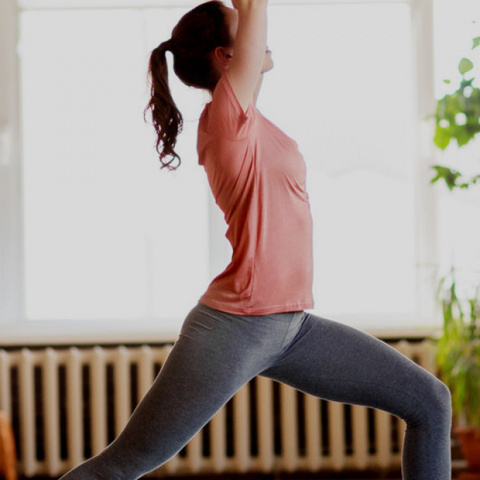Whether you’re new to running or you have been pounding the pavements for years, the chances are that you will have experienced an injury in some form or another. If you haven’t, it’s inevitable that you will in the future… or is it?
In a traditional model of training, a person continues training hard, increasing their volume and intensity of work so that they continue to adapt and improve. Progress normally continues in a linear fashion until such a time that they become injured. Only then do they consider lower intensity more functional exercises in the form of rehabilitation. However, more intelligent models of training focus on prehabilitation, anticipating potential injuries before they present and implementing strategies and exercises to improve function and form. Yoga has a great role to play in prehabilitation for runners.
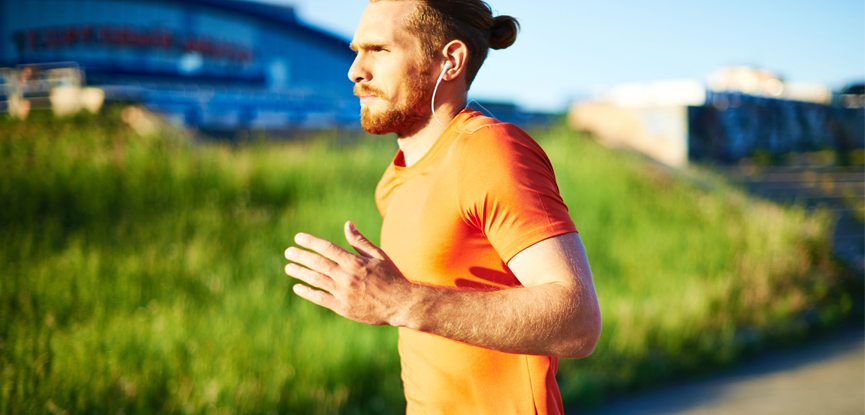
Running is clearly a great way to stay in shape, but it is a repetitive and high-impact activity that puts the body under a great deal of physical load. This load creates tension in the joints and can lead to musculoskeletal imbalances if the right exercises are not performed to counteract these stresses. Low back, knee, hip and shoulder pain are all very common in runners.
Why Runners Should Practice Yoga
Yoga is a highly restorative activity that helps to better align the running body. With repetition, particularly through a relatively short stride-length, the active muscles lose length via a process called adaptive shortening. Yoga, however, is renowned for the tremendous flexibility benefits that it provides, effectively reversing or preventing the shortening of muscles.
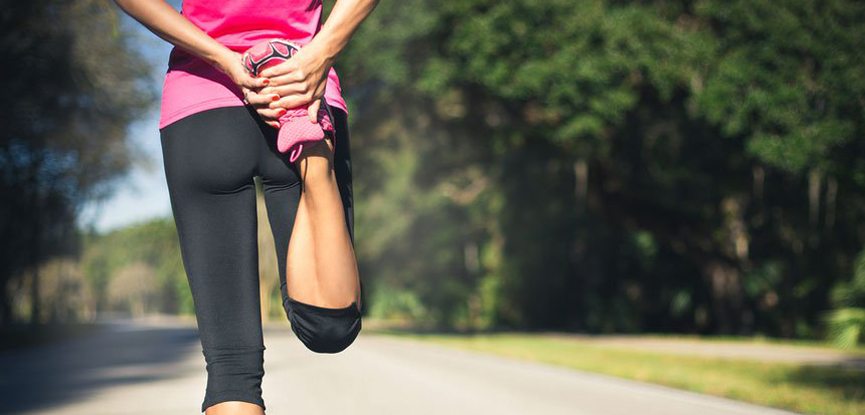
Furthermore, by increasing the flexibility of the joints, muscles and connective tissues, there is less opposition to movement throughout the body and so functionally it becomes more efficient. Compounded over many thousands of strides, this seemingly small energy saving really does add up, resulting in quite significant improvements in running performance.
It’s worth noting here that overly tight muscles often end up as weak muscles because they have an inability to fully contract and relax. Because of the overlapping nature of the filaments within muscle fibres, a short muscle is mechanically disadvantaged and subsequently, often loses strength.
With a programme of regular yoga practice, however, musculoskeletal balance can be restored and the muscles can return to their former glory. Functionally for runners, this can translate to greater stride length, better running economy and a reduced risk of injury.
The benefits yoga affords to runners are not limited to the legs, yoga is a great activity for improving core stability and mobility. By strengthening and mobilising the core, posture improves and unwanted compensatory movements during locomotion are also reduced – once again resulting in a better transfer of kinetic energy (energy resulting in motion).
Why the Core is So Important
Tight hamstrings are common in runners and they commonly cause low back pain and discomfort. The reason for this is that as the hip extends during the push-off phase of the stride, the hamstrings exert a downward force on the pelvis, causing it to tilt posteriorly (backwards) in a flattening motion.

As the leg swings forward on the swing phase of the stride, the hip flexors are activated, causing the pelvis to tilt anteriorly (forwards) and causes the curve in the low back to increase, resulting in compression of the facet joints. The more times this action is repeated, the more pressure and force is pushed through the low back and the greater the potential for pain. A similar effect can also take place at the same time in a lateral (side-to-side) plane of motion, further complicating increasing the strain in the low back region. With a stronger core, however, these unwanted and compensatory movements are minimised, resulting in a stronger and more stable running posture.
Beyond the Muscles
Most runners are attracted to yoga because they are enticed by the promise of higher levels of flexibility and lower levels of pain and discomfort. And rightly so, these are life-changing benefits.
However, yoga teaches students how to be more aware of, and have better control of the breath. Ensuring a steady flow of air into the body while running is fundamental to good running economy. When the breath is not controlled well, the accessory respiratory muscles have to be recruited and the process of respiration starts to become highly uneconomical. In such a scenario, fatigue is never far away.

Generally, aerobic exercise results in a short and shallow breath. Yoga teaches us, however, to breathe long and deep, using the whole of the lungs, rather than just the upper thoracic area. This deep breathing provides more air, which results in greater stability, and oxygen, resulting in higher levels of aerobic energy. Both of these have a positive and significant effect on running performance.
While yoga doesn’t alter total capacity, because this is largely determined by body size and genetics, the vital capacity, which is the portion of lung capacity directly involved in respiration, can be significantly improved. Studies have shown that a regular programme of hatha yoga can significantly improve vital capacity.
The mechanisms by which this is possible are not truly understood because yoga isn’t by definition an aerobic exercise. However, some of the most likely factors contributing to these improvements in respiratory functions include a greater ability of thoracic muscles to relax, greater control and awareness of respiratory muscles and a greater mobility, and subsequent compliance of the thorax during breathing.
Yoga clearly has a variety of benefits and those serious about improving their running performance should certainly consider building yoga into their training programme. We recognise that training itself is quite time-intensive and not everyone has the spare time to attend classes alongside an already gruelling running programme. In this case, we’d definitely advocate the inclusion of some yoga poses into the post-run stretches. Alternatively, try these poses on a lunch break or while watching TV.
The Poses
Downward facing dog
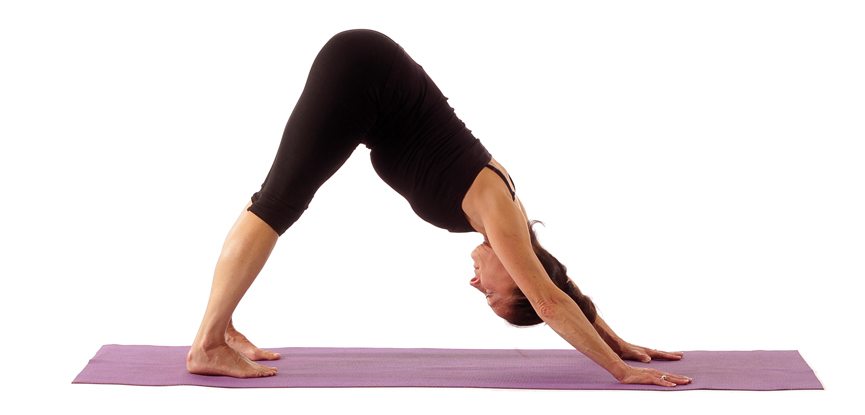
Begin on all fours, with your hands ahead of your shoulders, tuck your toes under and lift your knees from the floor, into an inverted V. Your arms, legs and back should all be straight. Extend your hips away from your thighs, up towards the ceiling. Push through your hands as though trying to take your chest towards your toes and ease your heels down to the floor. Hold this position for 5-10 breaths.
Head-to-knee pose
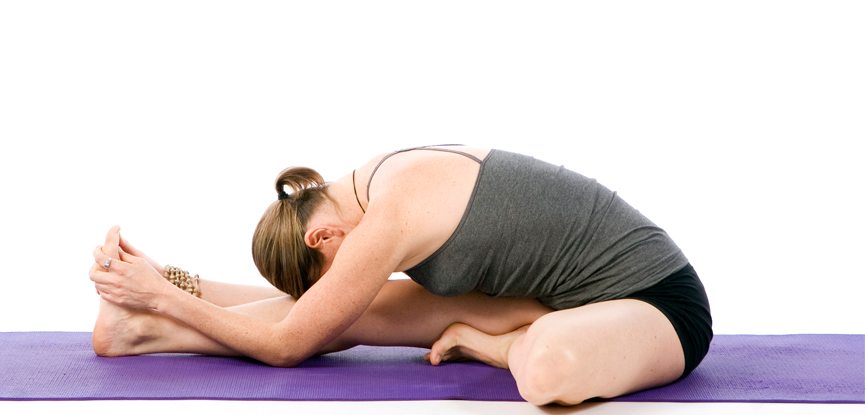
Sit on your mat with your left leg extended directly in front of you. Bend your right leg and place the sole of the foot onto your left inner thigh, as high towards the body as you can. Ease your knee down towards the floor to open up the hips and fold forward to deepen the stretch, extending your chest down towards your thigh. Hold for 3-5 breaths and repeat on the other side. This posture helps to release tension down the back of your legs, opens up your hips and relaxes the muscles in your lower back.
Hero pose
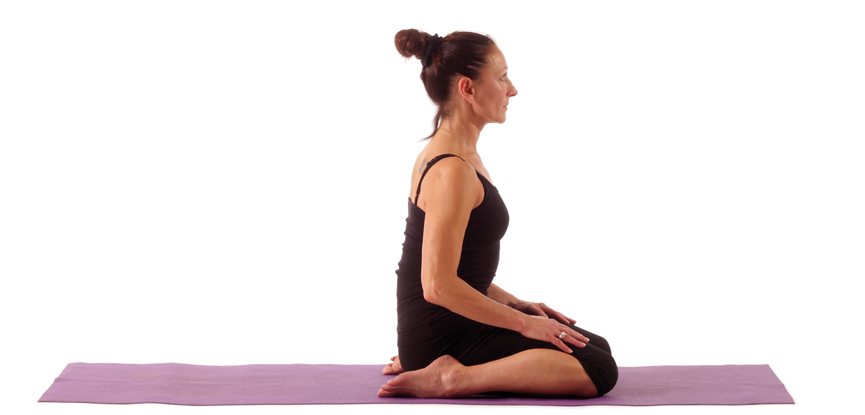
Begin with your knees together and feet outside of your hips, with your soles facing the ceiling. Sit between your feet, with your toes untucked. Push your feet down into the floor and release. Repeat 8-10 times. Hero Pose helps to increase blood flow to your legs, as well as release tension from your feet and shins. If you cannot sit in this posture because it’s too uncomfortable, try placing a yoga block, cushion or pillow below the hips to provide more support.
